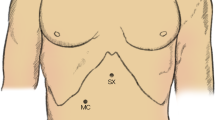Abstract
Common bile duct (CBD) stones are common in elderly patients. The laparoscopic transcystic approach with micro-incision of the cystic duct confluence in common bile duct exploration (LTM-CBDE) is a modified laparoscopic transcystic approach. Its safety and efficacy have not been studied in elderly patients with secondary choledocholithiasis. This study evaluates the safety and efficacy of LTM-CBDE in elderly (≥65 years) patients with secondary choledocholithiasis and compares the results with those in younger patients. In this retrospective analysis, 128 patients underwent LTM-CBDE from March 2007 to December 2013. The patients were divided into two groups according to age: the elderly group consisted of 50 patients aged ≥65 years and the younger group consisted of 78 patients aged <65 years. The preoperative morbidity rate, American Society of Anesthesiologists (ASA) score, previous abdominal operations, operation time, postoperative hospital stay, open conversion rate, postoperative complication rate, residual stone rate, recurrence rate and mortality were compared in both groups. The preoperative morbidity (41 vs. 28) and ASA score (2.5 ± 0.7 vs. 1.8 ± 0.6) were higher in the elderly group (P = 0.000, in both groups). No significant differences in previous abdominal operations, operation time, postoperative hospital stay, open conversion rate, postoperative complication rate, residual stone rate, recurrence rate and mortality (P > 0.05) were found between the two groups from March 2007 to December 2013. LTM-CBDE is a safe and effective treatment procedure for elderly patients with secondary choledocholithiasis. For suitable patients, we recommend LTM-CBDE as the treatment of choice.

Similar content being viewed by others
References
Dong ZT, GZ W, Luo KL et al (2014) Primary closure after laparoscopic common bile duct exploration versus T-tube. J Surg Res 189:249–254
Zhang HW, Chen YJ, CH W et al (2014) Laparoscopic common bile duct exploration with primary closure for management of choledocholithiasis: a retrospective analysis and comparison with conventional T-tube drainage. Am Surg 80:178–181
Gurusamy KS, Koti R, Davidson BR (2013) T-tube drainage versus primary closure after laparoscopic common bile duct exploration. Cochrane Database Syst Rev 6:CD005641
Yin Z, Xu K, Sun J et al (2013) Is the end of the T-tube drainage era in laparoscopic choledochotomy for common bile duct stones is coming? A systematic review and meta-analysis. Ann Surg 257:54–66
Chen XM, Zhang Y, Cai HH et al (2013) Transcystic approach with micro-incision of the cystic duct and its confluence part in laparoscopic common bile duct exploration. J Laparoendosc Adv Surg Tech A 23:977–981
Alkhaffaf B, Parkin E, Flook D et al (2011) Endoscopic retrograde cholangiopancreatography prior to laparoscopic cholecystectomy: a common and potentially hazardous technique that can be avoided. Arch Surg 146:329–333
Tabone LE, Sarker S, Fisichella PM et al (2011) To ‘gram or not’? Indications for intraoperative cholangiogram. Surgery 150:810–819
Sullivan DM, Hood TR, Griffen WO Jr (1982) Biliary tract surgery in the elderly. Am J Surg 143:218–220
Phillips EH, Toouli J, Pitt HA (2008) Treatment of common bile duct stones discovered during cholecystectomy. J Gastrointest Surg 12:624–628
Ceulemans R, Al-Ahdab N, Leroy J et al (2004) Safe laparoscopic surgery in the elderly. Am J Surg 187:323–327
Parra-Membrives P, Martínez-Baena D, Lorente-Herce JM et al (2014) Laparoscopic common bile duct exploration in elderly patients: is there still a difference? Surg Laparosc Endosc Percutan Tech 24:e118–e122
Lee A, Min SK, Park JJ et al (2011) Laparoscopic common bile duct exploration for elderly patients: as a first treatment strategy for common bile duct stones. J Korean Surg Soc 81:128–133
Hanif F, Ahmed Z, Samie MA et al (2010) Laparoscopic transcystic bile duct exploration: the treatment of first choice for common bile duct stones. Surg Endosc 24:1552–1556
Bove A, Di Renzo RM, Palone G et al (2014) Which differences do elderly patients present in single-stage treatment for cholecysto-choledocholithiasis? Int J Surg 12(Suppl 2):S160–S163
Holdsworth RJ, Sadek SA, Ambikar S et al (1989) Dynamics of bile flow through the human choledochal sphincter following exploration of the common bile duct. World J Surg 13:300–304
De Roover D, Vanderveken M, Gerard Y (1989) Choledochotomy: primary closure versus T-tube. A prospective trial. Acta Chir Belg 89:320–324
Acknowledgements
The authors would like to thank Enago (www.enago.cn) for the English language review.
Author information
Authors and Affiliations
Corresponding author
Ethics declarations
Conflict of Interest
The authors declare that they have no conflict of interest.
Human Rights
All procedures performed in studies involving human participants were in accordance with the ethical standards of the institutional and/or national research committee and with the 1964 Helsinki Declaration and its later amendments or comparable ethical standards. For this type of study, formal consent is not required. This article does not contain any studies with animals performed by any of the authors.
Rights and permissions
About this article
Cite this article
Niu, X., Song, J., He, X. et al. Micro-Incision of the Cystic Duct Confluence in Laparoscopic Common Bile Duct Exploration for Elderly Patients with Choledocholithiasis. Indian J Surg 80, 227–232 (2018). https://doi.org/10.1007/s12262-016-1574-y
Received:
Accepted:
Published:
Issue Date:
DOI: https://doi.org/10.1007/s12262-016-1574-y



